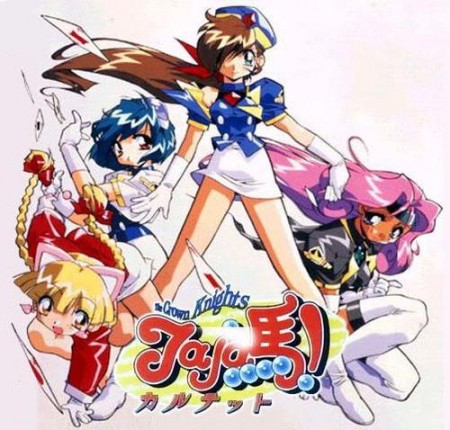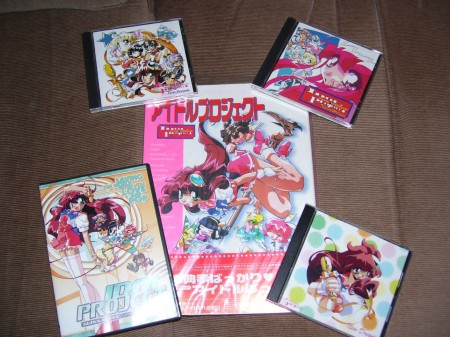Ask John: Which Anime Does John Love that No One Else Does?
![Petopeto-san_figures [excuse the dust]](https://www.animenation.net/blog/wp-content/uploads/Petopeto-san_figures-450x337.jpg)
Question:
I was wondering, are there any anime you like but everyone else hates?
Answer:
American otaku overlook or disregard a variety of anime genres and types, but the one variety which they typically do acknowledge but frequently disparage is especially cute moé & bishoujo anime. Since I happen to be a fan of cute girls, I immediately think of a few moé/bishoujo anime that I have a deep affection for that most of the rest of the world seems to venomously hate.
I first watched the two-episode Crown Knights JaJa Uma Quartet OVA series in late 1998, fansubbed by VHS-era translators “Studio Kakyouin.” The mini-series was later officially released in America by Central Park Media under the title “Wild Cardz.” Typical fan reactions to the show include, “Crap, just crap. Nothing was redeeming about this series at all,” “That was the stupidest and most void-of-sense piece of crap I have ever wasted my time to watch,” and “This was the worst anime I’ve seen in an awful long time!” A lot of harsh criticism gets levied at the series for its abundant emphasis on non-stop action rather than narrative or character development. From my personal perspective, I have no objections to an exuberant single non-stop action sequence that’s long enough to encompass two OVA episodes. Anime like Tenshi no Tamago, Fumoon, Arjuna, and Aku no Hana can tackle heavy, onerous themes. Sometimes I enjoy a simple, breezy, energetic anime that’s only aim is to provide non-stop animated action from beginning to end.
For my money, Macademi Wasshoi character designer Blade, Moetan character designer POP, and Petopeto-san character designer YUG draw the cutest girls in all of anime fandom. I fell in love with the 2005 Petopeto-san television series as soon as I laid eyes on it, and found that my appreciation for it grew as I watched it. I adore the cute character designs and find the underlying theme of traditional Japanese monsters trying to fit in and overcome discrimination from humans to be interesting and affecting. In several respects, Petopeto-san parallels themes and ideas found in the better known and more popular Kamichu! television series. I think that Petopeto-san was largely ignored, seemingly consciously, because its design crossed over an arbitrary line of cuteness that average Americans are willing to abide while Kamichu skirted in just beneath that imaginary ceiling.
I also watched the four-episode Idol Project OVA series for the first time during the VHS era, immediately falling under the spell of its infectious enthusiasm, catchy soundtrack and all-star seiyuu cast. The fan reaction to thie 1995 series varies from fairly positive, “… this wildly creative and unique show… is worth the rental just for the experience,” to mixed, “An otherwise ‘meh’ series saved by the visuals,” to distinctly negative, “Idol Project was terrible.” The very reason I watch anime is to be transported to alternate worlds culled from creative, artistic minds. Certainly other bishoujo anime may have more literary and narrative substance, but few other bishoujo anime have as much enthusiasm, verve, and unadulterated eccentric spontaneity as Idol Project. The show receives criticism for being excessively cute and having insubstantial narrative depth, but those are exactly among the attributes that make me appreciate the series so much.
The 2008 three-episode CG anime OVA series Hoshi no Umi no Amuri typically gets overlooked, and fans that do watch it frequently seem to come away unimpressed. “This show just didn’t have much going for it,” and “I would recommend skipping the 1st episode entirely… I definitely enjoyed the 2nd episode a lot more.” Creator Yoshitomo Yonetani’s cute, innocent girls in space adventure is wildly imaginative and filled with the sort of bizarre, kooky ideas and elaborate action sequences that seemingly only Japanese animation is capable of illustrating. Once again, the mini-series from the director of the popular Tiger & Bunny movies gets heavily criticized for lacking story and character development. But I’m absolutely content to appreciate the show’s wonderful whimsical sci-fi fairy-tale-esque aesthetic.
Add a Comment
You must be logged in to post a comment.




Well i got almost exactly the same set of figures (and i have nearly no figures else) so obviously you are not the only one.
I think the problem with PetoPeto-San is that not everyone gets the (or dares to get) the imouto theme, i mean “Town of little sisters”… nevertheless i liked it very much.
I’m happy to see someone else actually likes Project Idol! I have a romance with anime OVAs that started off with gaming. I find myself wanting to play the games to see more of the story behind it..but have trouble finding them 🙁
I absolutely love Galaxy Fraulein Yuna and have been collecting as much of the merchandise as I can: (http://industrialhoney.tumblr.com/search/galaxy+fraulein+yuna).
As a stand alone OVA piece most watchers have no clue what was going on.